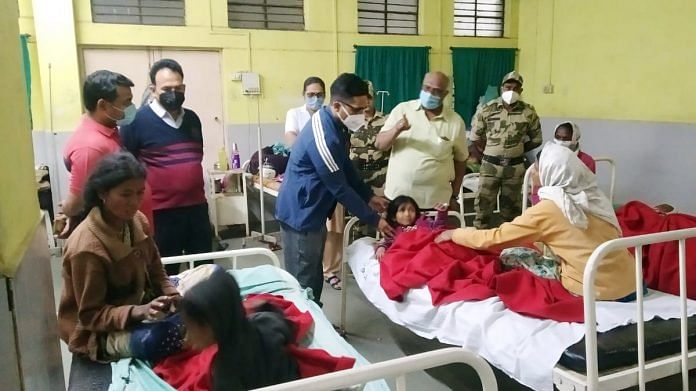New Delhi: As many as 30,38,000 children in India likely missed their first vaccine dose against diphtheria, tetanus, and whooping cough in 2020, as opposed to 14,03,000 children in 2019, a new report has found.
This means an additional 16 lakh Indian children may have missed their routine vaccinations against diphtheria, tetanus, and other vaccine-preventable childhood diseases due to disruptions created by Covid-19, increasing the risk of future outbreaks and deaths, according to data released by WHO and UNICEF Thursday.
Globally, 230 lakh children missed out on basic vaccines through routine immunisation services in 2020 — 37 lakh more than in 2019 — according to the data. This latest set of comprehensive worldwide childhood immunisation figures, the first official figures to reflect global service disruptions due to Covid, show a majority of countries last year experienced drops in childhood vaccination rates.
As many as 170 lakh children likely did not receive even a single vaccine during the year, with vaccinations in South Asia likely the worst hit.
Meanwhile, another study published in The Lancet journal Thursday showed that India’s coverage for the first dose of measles vaccine is likely to have fallen below 86 per cent, and coverage for the third vaccine dose against diphtheria, tetanus, and whooping cough, under 75 per per cent.
“In 2021 and beyond, countries such as India are likely to face ongoing challenges due to the COVID-19 pandemic. New surges of COVID-19 amid the emergence of new variants, rising poverty in many countries due to the economic impacts of the pandemic, and the crucial need to expediently roll out COVID-19 vaccines are all likely to continue to put stress on health systems,” Kate Causey, lead author of the research paper in The Lancet told ThePrint.
“If these gaps aren’t filled, these pandemic-associated disruptions to immunisation may increase the risk for a resurgence in vaccine-preventable diseases in the months and years to come — particularly in countries and communities already at high risk prior to the pandemic,” said Causey, a researcher at University of Washington’s The Institute for Health Metrics and Evaluation (IHME).
Measles, diphtheria, tetanus, and pertussis are four vaccine-preventable childhood diseases targeted by immunisation programmes around the world, with measles claiming the lives of over 207,000 people in 2019.
The WHO and UNICEF also released figures assessing mixed vaccinations, which found that in India as many as 30,38,000 children likely missed their first vaccine dose against diphtheria, tetanus, and whooping cough in 2020, as opposed to 1,403,000 children missed in 2019. India is experiencing a significant drop, with DTP-3 coverage falling from 91 per cent to 85 per cent, the WHO said in a statement.
Also read Delta variant transmissibility likely to up Covid cases & pressure on healthcare, WHO warns
Healthcare around the world under pressure
The Lancet study estimated that global coverage for the first dose of measles vaccine (MCV1) and coverage for the third vaccine dose against diphtheria, tetanus, and pertussis (DTP3) may both have fallen below 80% in 2020 — a relative decline of at least 7% below expected levels for both vaccines had the pandemic not occurred.
Covid-19 and the pressure it has put on healthcare around the world, researchers say, may be the largest and most widespread global disruption to life-saving immunisation programmes in history, “putting millions of children — in rich and poor countries alike — at risk for measles, diphtheria, tetanus, and pertussis (whooping cough).”
Combined with disruptions to planned mass vaccination campaigns in 2020, these declines in routine vaccination could increase the risk of future measles outbreaks and deaths, researchers say.
“For India, we estimated that 2020 vaccine coverage in the absence of COVID-19 would have been 88.1% for DTP3 and 95.1% for MCV1,” Causey, a researcher at University of Washington’s The Institute for Health Metrics and Evaluation (IHME), told ThePrint.
However, due to the disruptions attributable to the Covid-19 pandemic in India the estimated annual 2020 coverage levels for DTP3 and MCV1 to be 74.2% and 85.7%, respectively.
This translates to a 15.8 per cent decline in DTP3 vaccinations, and 9.8 per cent decline in MCV1. “These estimates are informed by monthly data from the Indian Health Management Information System through June of 2020,” said Causey, adding that the rest of the year is based on projections of the model.
Although the disruptions to vaccine delivery in 2020 were lowest in sub-Saharan Africa, the researchers caution that many countries in sub-Saharan Africa already had low routine vaccination coverage prior to the pandemic.
In high-income countries the number of children who missed doses of each vaccine more than doubled due to pandemic disruptions in 2020 — with missed doses of DTP3 rising from an expected 600,000 to an estimated 1.2 million; and missed doses of MCV1 from 700,000 to 1.5 million.
Also read Maharashtra’s 23,000 ‘backlog’ deaths skew India’s fatality rate, but it isn’t only offender
South Asia the most acutely affected region in 2020
Although the findings suggest that by December 2020 monthly doses administered worldwide began nearing expected levels, the ongoing Covid-19 transmission, the emergence of new variants, and a focus on Covid-19 vaccine roll-out could stall or reverse these positive trends.
The study found that South Asia was the most acutely affected region in 2020, with an estimated 3.6 million doses of DTP3 and 2.2 million doses of MCV1 vaccine missed by eligible children due to the pandemic — almost twice as many as expected.
Regional coverage of DTP3 was estimated to have fallen by 13% and MCV1 by 4%, relative to expected levels.
Also read Joe Biden to nominate Indian-American surgeon Atul Gawande to senior USAID position






